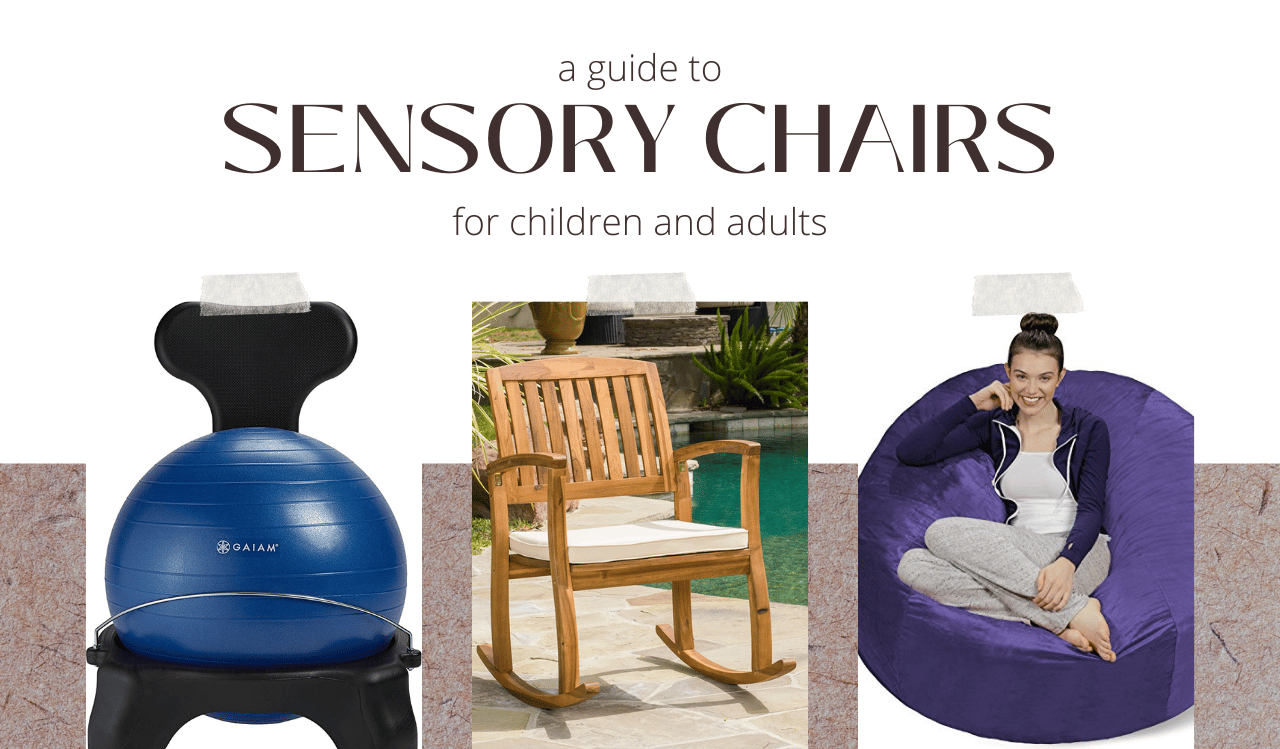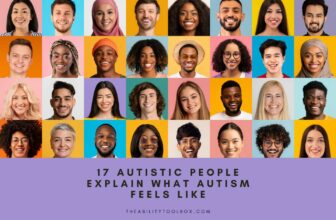
Sensory chairs can help children and adults with autism, ADHD, anxiety, and/or sensory processing disorder to focus at work and school. For neurodivergent people, our environment is extremely important to our success. Addressing our sensorimotor needs can help us to self-regulate and prevent meltdowns and panic attacks. As an autistic adult, I want to help empower neurodivergent people of all ages to support our unique skills and challenges. I hope this in-depth guide to sensory chairs can help you evaluate the wide variety of options available and choose the right active seating for your needs.
These are our top recommendations for sensory chairs — all recommended and used by neurodiverse adults and kids.
1. Best Sensory Chair for Office and Computer:
- Yoga Ball Chair — Stay active while working at your desk
- Kids Yoga Ball Chair — Helps kids with ADHD and autism stay on task during homework time
2. Best Sensory Chair for Classrooms:
- Wobble Stool — Encourages children with high distractibility, sensory challenges, or ADHD to get their wiggles out while remaining in their seat, helping them stay seated longer and focus better.
3. Best Sensory Chair Add-On for School Desks:
- Wobble Cushion — This portable version of the wobble stool can be used with school desks or added to any chair to help autistic and ADHD kids and adults fidget in a healthy way while staying focused.
4. Best Sensory Chair Beanbag:
- Moon Pod — The world's most comfortable relaxation chair for all ages. A perfect place to recover from autism meltdowns, sensory overload, panic attacks, and all the other stresses of neurodivergent life.
5. Best Therapeutic Compression Sensory Seating:
- Peapod Sensory Chair — This therapeutic chair embraces you in a hug to aid in sensory regulation. It can fit 2 to 3 children or 1 adult.
6. Best Floor Rocking Chair:
- X Rocker — Rocking is a natural stim for many people with autism and ADHD, and this rocking sensory chair is perfect for studying or gaming.
How Sensory Chairs Work
Sensory chairs can help children and adults with ADHD, autism, other neurological conditions, and even neurotypical people to focus while working or studying. Sensory chairs provide various forms of movement and sensory stimulation to the person who sits on them. They may wobble or rock, spin, and/or provide compression or the feeling of being hugged. Each of these sensations can fulfill our natural human needs for movement and fidgeting, which can be magnified in people with sensory processing conditions such as autism, ADHD, sensory processing disorder, cerebral palsy, Down syndrome, and more.
Multiple research studies show that using a stability ball can improve children’s performance in the classroom. For example, a study published in the American Journal of Occupational Therapy found that fourth and fifth-grade students who used a stability ball in the classroom showed increased levels of attention, decreased levels of hyperactivity, and increased time on task. Teachers also noticed these differences and preferred the stability balls compared to regular classroom chairs.
Another study of active seating published in The Physical Educator compared three groups of sixth-grade students in math classrooms in Minnesota. One group did no physical exercise during the class, another had two 5-minute physical activity breaks during class, and the third class used stability balls. Both classes that engaged in physical activity demonstrated improved standardized test scores, but the class using stability balls improved the most compared to the other groups.
How to Choose the Right Sensory Chair
When choosing a sensory chair for yourself or your child, here are several important factors to consider.
1. Choose a seat that meets their individual sensory needs.
Each neurodivergent person has different sensory needs that should be taken into account. For example, some people are hypersensitive and certain forms of movement may bother them, while others are hyposensitive and may need additional proprioceptive input to thrive.
2. Decide how you will use the sensory chair and the goals you want the chair to help accomplish.
Consider the types of sensory input that help you or your loved one achieve the goals for which you are purchasing the sensory chair. Many sensory chairs are designed to increase focus and provide an outlet for fidgeting, but others may be used to provide calming sensations and prevent or defuse a meltdown.
3. Be sure to consider the person's general physical ability and balance.
Not all sensory chairs work for all people. For example, children and adults with hypotonia or spasticity may have difficulty balancing on a wobble stool or stability ball. If they're struggling not to fall, that will make it hard to concentrate. For people with impaired physical coordination, a supportive chair combined with bouncy bands, foot fidgets, or handheld fidget toys may be a better option. If you’re considering a beanbag chair or other calming chair for someone with limited mobility, make sure it is soft enough to provide comfort but not so soft that the child or adult can’t climb out of it easily.
4. Use multiple types of seating as part of an overall sensory-friendly environment.
You may find that having multiple seating options works best for yourself or your child, depending on the task at hand, the person's mood, and the general sensory environment. Speaking of which, sensory chairs work best when combined with an overall environment that is conducive to sensory regulation. Using noise-canceling headphones and soothing sensory lighting can help create a space where it’s easy to focus and remain calm.
Sensory Chairs We Recommend
I've gathered a variety of sensory seating, going beyond the usual active chairs you may have seen elsewhere to help you find the right solution for yourself or a loved one.
Sensory Chairs for Work and Studying
These sensory chairs are perfect for the office, working from home, or doing homework.
Ball Chairs and Stability Balls
Yoga ball office chairs are popular with adults and teens who want to stay active and focused while working at a desk. If you prefer extra balance support, choose a chair with a back. If you need to move around more, a backless stability ball chair may be your ideal work seating.
Kneeling Chair
Kneeling chairs are an ergonomic form of seating that some fidgeters may find more comfortable. They also allow the user to rock back and forth, a sensation many autistic people (including me) enjoy.
Active Stools and Chairs
Active seats, also known as wobble stools, are popular in classrooms to support students with ADHD and autism, but can be used by neurodiverse people of all ages. They are best for kids and adults who have good balance, and may not be suited for those with physical disabilities or conditions such as dyspraxia that affect coordination.
Sensory Chairs and Accessories for School Classrooms
These sensory chairs and accessories are designed to work with typical desks in school classrooms.
Wobble Cushions
Stuck with regular school desks? A wobble cushion turns them into instant fidget chairs. Plus, since the frame of the desk is stable, a wobble seat may be a better option for kids with developmental coordination disorders or balance issues.
Senseez Vibrating Sensory Cushions
These sensory cushions provide tactile and proprioceptive feedback for sensory seekers and help them focus in distracting environments.
Bouncy Bands and Foot Fidgets
Foot fidgets can be used with or without sensory chairs, and allow people to stim while keeping their hands free for typing, writing, or holding a book. Bouncy bands attach to school desks to help kids who tap their feet and/or struggle to stay in their seats during class. You can attach them to dining chairs at home, too!
Moon Pod Sensory Chair
The Moon Pod is like a bean bag, but so much better. The unique custom beads inside create a zero-gravity experience so you feel like you're floating on a cloud. Plus, the single version is only 12 pounds, compared to the 45 pounds of a typical beanbag, so it's easy to move it from room to room or out of the way if you need extra floor space. Although it's more expensive than a standard beanbag, it is well worth the price, plus we've got an excellent discount code below. I sit in my Moon Pod when I'm in an autistic shutdown or on the verge of a meltdown and it really helps!
Click here and enter code PARTNER25 at checkout to get 25% off sitewide!

Beanbag Sensory Chairs
Beanbag chairs naturally fit to the body, helping to calm neurodivergent kids and adults who are overstimulated by stress or too much sensory input. Big Joe makes a beanbag chair for any size and need, and they offer both traditional bean and foam fillings.
Big Joe Beanbag Chairs
More Beanbag Chairs
Hugging Sensory Chair
Deep pressure stimulation can be tremendously helpful for children and adults on the autism spectrum. Temple Grandin had to invent her own “hug box,” but today we have weighted blankets and vests — and these sensory chairs that feel like you're sitting in a hug.
Sensory Chairs for Rocking
Rocking is a natural, healthy, and comforting stimming behavior for people on the autism spectrum — and neurotypical people too. Rocking can help reduce stress, prevent autism meltdowns, calm kids and adults who are experiencing panic attacks, and so much more.
Rocking Chair
You really can't go wrong with a classic rocking chair. Here are a few indoor and outdoor rockers I like — and a glider if you prefer your sensory chair to have a sliding motion with less bouncing.
Climbing Arch Rocker
This multi-functional furniture for toddlers can be used for climbing and developing coordination. Then just flip it over and with the included pillow, it becomes a comfortable rocker.
Floor Rocker for Gaming or Studying
Floor rockers are usually associated with playing video games, and they're great for that purpose, but they can also be used for reading and studying. Some feature built-in speakers with Bluetooth, so you can listen to guided meditation or your favorite lo-fi chill beats.
Sensory Seating for Bouncing
Children and adults who are hyperactive and/or sensory-seeking often love to bounce. A simple ball with a handle can fulfill this need and is safer than a trampoline.
Bouncy Balls
Egg Sensory Chair
I love vintage design, and a comfortable retro egg chair is a great place to decompress from sensory overload.
Sensory Swings
Looking for sensory swings? We have an entire article devoted to them here.
Do you have favorite sensory chairs we should add to this guide?
Let us know in the comments.
More Neurodiversity & Autism Resources in The Ability Toolbox
- Comfortable Autism Noise Canceling Headphones and Earplugs
- Why the Autism Puzzle Piece Is Bad, and What to Use Instead
- Autism T-Shirts and Clothing to Celebrate Neurodiversity Acceptance
- Sensory Swings for Kids and Adults with Autism or ADHD: A Guide
- Sensory Overload Self-Help Guide: Coping Tips to Help You Thrive
Hey I'm Olivia and I'm a proud Autistic woman. My special interests are cats, stim toys, and electronic music! I love to write and help other Autistic adults find ways to enjoy life in this LOUD world!
Dr. Wilson graduated from Rosalind Franklin University of Medicine and Science and completed her residency in Internal Medicine at Advocate Good Shepherd Hospital in Barrington, IL. Dr. Wilson specializes in providing culturally competent and trauma-informed care to patients with physical disabilities. In addition to her private practice, she works as a science communicator, teaching health literacy to middle school and high school students in her local school district.


















































Start the discussion at community.theabilitytoolbox.com